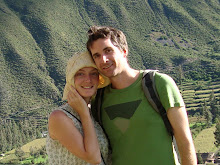 The cathedral on the main square
The cathedral on the main square
Our first stop in  The bus station in Esteli
The bus station in Esteli
We hope to either settle here or in the colonial student city of  Walking the streets
Walking the streets
It’s exciting to think about stopping in one place for a while and so far, things are looking promising. All around Estelí are beautiful mountains covered in forest and green farming land. Estelí itself isn’t stunning – all single or two-storey buildings set around a big central square with an impressive cathedral. It has a good atmosphere though, lots of local restaurants, clothes shops, bars and cafés.  The main commercial street
The main commercial street
There is a bit of an international scene and a few tourists pass through. Locals seem really friendly and it is somewhere we can imagine living for a while.  The local cinema on the main square, either The Terminator or Over my Dead Body.
The local cinema on the main square, either The Terminator or Over my Dead Body.
It’s boiling hot in the day when the sun comes out, but as it’s up in the mountains, it’s a bit fresher than much of
We met a British lady, Janie, who has set up a café and hostel here and has worked for years in
 When we arrived here a talk was taking place with a small group of Americans, who it turned out were part of an organisation called Witness for Peace which began during the Nicaraguan civil war to document people’s testimonies and serve as an alternative information source to the US press at the time whose propaganda was in favour of the rightwing government. A lady was speaking to them, who is now in her 60s and had joined the Sandinistas to fight in the revolution. We joined the group to listen to her story. She had had to leave her three daughters behind, two with her sister who had starved them because she didn’t think her sister should be a Sandinista. She had lost her son and nephew during the revolution, they had been killed and decapitated by the National Guard, aged 16 and 18. Her story was heroic, incredibly brave and harrowing.
When we arrived here a talk was taking place with a small group of Americans, who it turned out were part of an organisation called Witness for Peace which began during the Nicaraguan civil war to document people’s testimonies and serve as an alternative information source to the US press at the time whose propaganda was in favour of the rightwing government. A lady was speaking to them, who is now in her 60s and had joined the Sandinistas to fight in the revolution. We joined the group to listen to her story. She had had to leave her three daughters behind, two with her sister who had starved them because she didn’t think her sister should be a Sandinista. She had lost her son and nephew during the revolution, they had been killed and decapitated by the National Guard, aged 16 and 18. Her story was heroic, incredibly brave and harrowing.
All around town are colourful murals, commemorating heroes of the revolution amongst other things.  'People that do not know their history and do not pass on traditions from parents to children, are a people that do not deserve the right to survival'
'People that do not know their history and do not pass on traditions from parents to children, are a people that do not deserve the right to survival'
 A mural on a bar depicting a traditional folk character and revolutionary images.
A mural on a bar depicting a traditional folk character and revolutionary images.
 We're not sure what this is, but it looks nice
We're not sure what this is, but it looks nice
 Pre-revolutionary hero, Carlos Fonseco, on a shop
Pre-revolutionary hero, Carlos Fonseco, on a shop
In 2006, Daniel Ortega, a Sandinista was voted into power. The country is divided on to what extent this is a good thing, many people feel that much of what they fought for nearly 30 years ago is beginning to take shape whereas others fear a leftwing Chavez-style leadership. People certainly have an opinion anyway and it is a really exciting time to be in the country. We’re looking forward to learning more from people over the coming months.



No comments:
Post a Comment